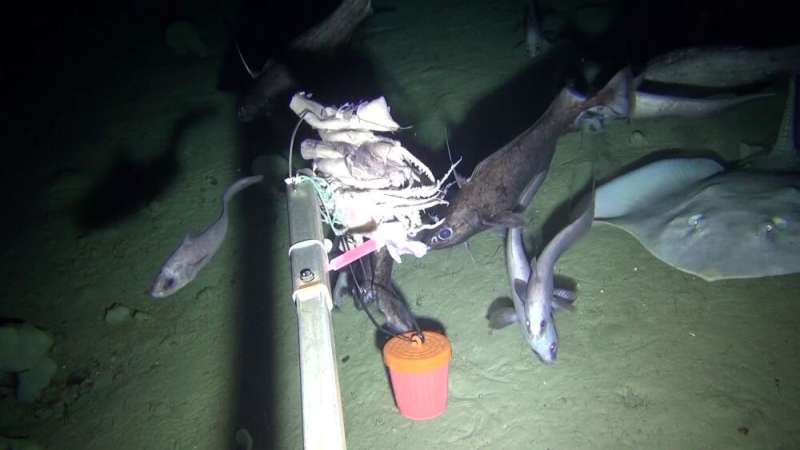A baited camera trap of fish at a depth of over 2000 meters. Credit: David Cote, Fisheries and Oceans Canada
A new study demonstrates the effectiveness of a novel method for using DNA in seawater samples to determine which fish species are present in a given part of the deep sea. A team of scientists from eDNAtec Inc. and colleagues from Fisheries and Oceans Canada and Memorial University present these findings in the open-access journal PLOS ONE on November 4.
The ability to monitor deep-sea fish diversity is necessary for implementing sustainable management efforts and understanding the impacts of commercial fishing and climate change. However, existing methods such as baited camera traps, trawling, and acoustic monitoring, have limited detection capabilities and are difficult to use in much of the ocean.
A newer method called eDNA metabarcoding reveals which fish are present in a given habitat by analyzing environmental DNA (eDNA)—DNA that is shed by organisms into the surrounding environment as they go about their normal activities.
To evaluate the effectiveness of eDNA metabarcoding for detecting deep-sea fish, McClenaghan and colleagues applied it to seawater samples collected from the Labrador Sea at depths of up to 2,500 meters. In deep-sea water samples (depths of 1,400 meters or greater), eDNA metabarcoding identified 11 fish families, 11 genera, and 8 species. The researchers compared their eDNA metabarcoding results to those obtained by conventional methods and found that they provided broader coverage of fish diversity and other taxa while using significantly less logistical effort. These advantages make eDNA techniques an important advancement for large-scale monitoring applications.
The research team also explored eDNA metabarcoding using various volumes of deep-ocean seawater samples and different DNA primers—short strands of DNA applied in the laboratory analysis of eDNA to determine which species are present. Their findings suggest that the deep ocean environment requires some adjustments to methods used in shallower waters, such as using larger volumes of water and the use of multiple primers to maximize species detection.
While the authors plan to further refine eDNA metabarcoding procedures for the unique nature of the deep-sea environment, they note that this method already can provide important insights for monitoring fish diversity in the deep ocean.
The authors add: "Advances in genomics and computational tools are rapidly expanding our ability to study and monitor biodiversity, a much needed task in the face of rapid and vast environmental change. Our study demonstrates the utility of eDNA analysis for the challenging endeavour of monitoring fish species in deep ocean and sets the stage for adoption of this approach by various stakeholders."
More information: McClenaghan B, Fahner N, Cote D, Chawarski J, McCarthy A, Rajabi H, et al. (2020) Harnessing the power of eDNA metabarcoding for the detection of deep-sea fishes. PLoS ONE 15(11): e0236540. doi.org/10.1371/journal.pone.0236540
Journal information: PLoS ONE
Provided by Public Library of Science
























